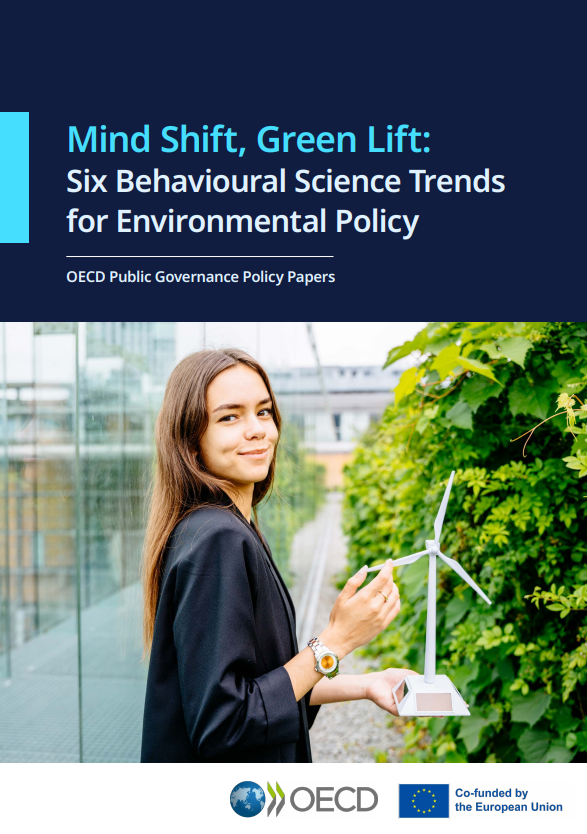Mind shift, green lift: Six behavioural science trends for environmental policy

Executive Summary
Human behaviour is at the core of the green transition: transitioning to a sustainable, low-carbon economy hinges on behavioural shifts across all individuals, businesses and governments. Individuals must adopt energy-efficient technologies and reduce carbon-intensive consumption, while businesses must integrate sustainable practices.
Governments can help drive these shifts and shape sustainable behaviours across all levels of the economy – from corporations and communities to individuals and policymakers. Using a range of policy tools, such as regulations, financial incentives and public campaigns, they shape the choices of businesses and individuals, guiding behaviour toward long-term sustainability.
Behavioural science is key to making environmental policies more effective. Understanding how people behave can boost policy impact, improve adoption of green behaviours, strengthen public support and maximise the likelihood that policies achieve their desired behavioural outcomes, thereby reducing unnecessary expenditure of public funds. Applying behavioural science to both supply-side and demand-side policies enables governments to drive immediate environmental action while fostering lasting behavioural change.
The OECD has identified six key trends in which behavioural science is driving the green transition in public policy. Based on an analysis of more than 100 case studies, these trends provide a roadmap for policymakers looking to embed behavioural science into their environmental policies.
Six key trends
- Trend 1: Behavioural science informs environmental policies at every stage of the policy cycle. Governments are using behavioural science throughout the policy cycle – from problem identification to design, implementation and evaluation. This approach leads to more targeted and effective environmental policies grounded in real-world human behaviour.
- Trend 2: Governments leverage behavioural science in climate adaptation efforts. Behavioural science is increasingly used in climate adaptation efforts, helping governments enhance policy effectiveness and secure stakeholder engagement. Monitoring and evaluating behaviour allows for better integration of adaptive measures across sectors, from businesses to households.
- Trend 3: Governments use behavioural science to predict and account for public acceptability of green reforms. Understanding public perceptions is critical for effective environmental policies. Governments increasingly rely on behavioural data to understand citizens’ climate knowledge, support for reforms and behaviours. This data helps shape clearer, more accessible policies aligned with public values, fostering greater trust and reciprocity between citizens and the government. By refining policy design and communication based on this data, governments can boost public engagement, support and encourage sustainable behaviours, improving the integrity and effectiveness of green reforms.
- Trend 4: Governments use behavioural science to boost citizen participation in environmental policies. Governments are increasingly using behavioural science to enhance citizen participation in environmental policymaking. By leveraging behavioural science, they aim to understand what motivates citizen participation, strengthen trust between citizens and the government, reduce barriers and make policy processes more inclusive.
- Trend 5: Governments use behavioural science to increase the demand for sustainable goods, services and technologies. Demand-side policies, which influence technology choices and consumption patterns, are essential for advancing the green transition alongside supply-side measures. Governments increasingly use behavioural science to understand and shape the choices of consumers, users and citizens. This understanding informs policies that promote pro-environmental behaviours, reduce unsustainable consumption and encourage the shift towards sustainable goods, services and technologies.
- Trend 6: Governments harness behavioural science to build resilience to climate misinformation. The spread of climate misinformation can undermine efforts to promote individual and collective actions for the green transition. To counter this, governments are increasingly applying behavioural science to build resilience against climate misinformation. This involves measuring susceptibility to misinformation, identifying factors driving its spread and developing behaviourally-informed strategies to prevent its occurrence and mitigate its impact.
What can governments do?
While these trends vary in prevalence and development, they highlight actions governments can take to accelerate the green transition:
- Understand and address attitudes and behaviours towards sustainability. By identifying drivers and barriers to sustainable practices, policies informed by real behaviour that the public is more likely to engage in and comply with can be developed.
- Incorporate behavioural considerations throughout the policy cycle. Define policy problems, anticipate responses and build a robust evidence base using behavioural science data. Leverage this data to assess, fine-tune, implement and evaluate environmental policies effectively.
- Implement demand-side strategies targeting consumers, users and citizens to drive sustainable behaviours. Design interventions informed by behavioural science to promote sustainable behaviours and create a self-reinforcing cycle of change. These actions can shape consumer habits and drive the green transition, producing a ripple effect across society.
- Prioritise public involvement, especially for those disproportionately affected by climate change: Use behavioural science to engage a range of stakeholders, building societal support and trust. Design and test interventions with behavioural science and citizen feedback to ensure inclusive, long-term decision-making.
- Integrate behavioural science to refine decision-making and policy processes within government. Reduce cognitive biases, optimise governance tools and enhance policy effectiveness through robust monitoring and behavioural evaluation. Ensure adaptive, behavioural, data-driven approaches to emerging challenges and long-term sustainability.
- Create conditions for positive social tipping points to accelerate the green transition: Governments should maximise opportunities to accelerate the green transition by creating enabling conditions for positive climate social tipping points. By leveraging behavioural science, governments can identify critical moments when change is possible and create conditions that support behavioural shifts and sustainable transitions.
This policy paper is co-funded by the European Union. Its contents are the sole responsibility of the authors and do not necessarily reflect the views of the European Union.


Mind shift, green lift: Six behavioural science trends for environmental policy
Published: 29 January 2025
